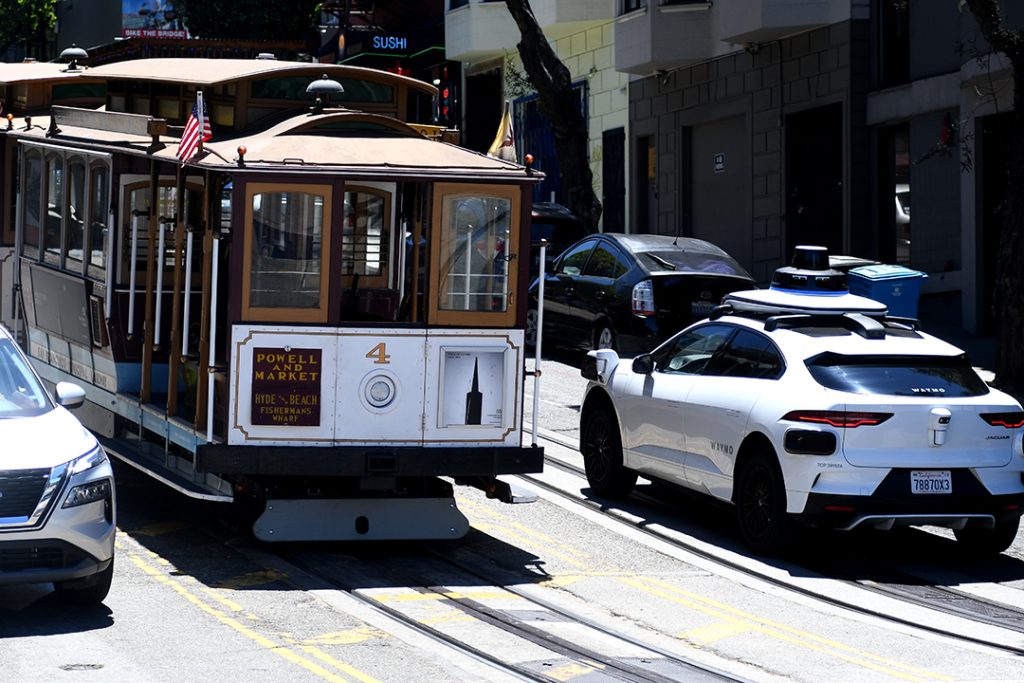Summarize this content to 2000 words in 6 paragraphs
A self-driving Waymo car passes a San Francisco trolley in a juxtaposition of transportation evolution. (Photos by JiaYing Grygiel)
You’ve probably ridden your share of weird taxis and ride-hails, with overpowering air freshener and sticky plastic-covered seats.
A self-driving car, however, is a luxurious experience. It’s a super smooth ride in a sleek Jaguar SUV — with a steering wheel that spins on its own like an Ouija board.
Robot cars are the stuff of science fiction. Except in San Francisco, Waymos humming around the city 24/7 are a common sight. It’s still relatively new — the waitlist was just removed in June — and you’ll often see passengers filming as they ride.
Waymo began in 2009 as the Google self-driving car project, and first opened to the public in Phoenix in 2018. San Francisco came next, and Los Angeles currently has a waitlist. Between these three cities, Waymo counts 2 million fully autonomous rides taken by the public to date. The company announced this week it is expanding in S.F. and L.A. There’s also a waitlist for Austin.
Waymo tested its cars in Bellevue, Wash., in 2022, but the Seattle area isn’t one of its current priorities. “It could happen, but it’s not on our immediate roadmap,” said spokeswoman Angelica Price-Rocha.
While in San Francisco, I couldn’t resist trying out these futuristic self-driving cars. Spoiler: no one got hit.
How to ride
Just download the app. Even for me, a total Luddite, the Waymo app was shockingly easy to install and use, no learning curve at all. You just plug in your credit card info and watch money drain from your account.
Type in where you want to go and the Waymo app tells you how long to wait and what your ride will cost. Even though I was standing in front of a hotel pull-in, Waymo directed me to a parking lot across the street for pickup. Another time, I was standing in a parking lot and Waymo had me walk to a less busy lot.
You can’t flag down a Waymo, even if you see an empty one cruising by. Waymos go to a depot to get recharged, otherwise they drive around the city until they get hailed.
On my first trip, I saw my ride approaching and tried to wave it down. Then I realized how silly I looked waving to a self-driving car.
The Waymo pulls up. You use your phone to unlock the doors, and slide in. The interior is immaculate, and the AC refreshing. There’s gentle elevator music in the background. You can change the temperature and music to suit your personal preference using the app.
A silky female voice welcomes you and goes over what to expect. Buckle up, then press “start ride” on the passenger screen.
Each Waymo fits four passengers, one in the front and three in the back. No one gets to sit behind the steering wheel. (Why is there even a driver’s seat?) Luckily my kids are past car seat age, but if you have little ones, you need to schlep your own car seats.
To use the trunk, tap “open trunk” on the app. It was roomy enough to fit three carry ons and three backpacks. When you get dropped off, the trunk automatically pops open and Waymo reminds you to grab your things.
Since there’s no driver, there’s no one to tip. Also, there’s no one to rate, and no one to rate you.
Is it safe?
Sure.
During the ride, you can follow along on the two in-car screens and see what Waymo sees. Waymo registers pedestrians and others cars in blue, cyclists in green. It even seems to sense pedestrians hesitating on the curb. Who wants to find out what happens if you race out in front of a Waymo?
Pro: Unlike drivers on their phones, Waymo doesn’t get distracted. The sensors on the front, back, sides and top of the car are constantly whirring. It’s a machine.
Con: Theoretically Waymo can parallel park, but it dropped me off in the middle of the street, blocking traffic. (Sorry, guys behind me). One taxi driver told me he got stuck behind a Waymo that was confused by a rolled up carpet in the road. It’s a machine.
Cost
Waymo is more expensive than a regular rideshare.
A 1.6-mile Waymo ride from Fisherman’s Wharf to Union Square cost $27.05. A Lyft for the same trip cost $15 to $17. My Waymo did a strange zig zag around the waterfront, adding a mile to the trip.
What about the human cost? Waymo covers the entirety of San Francisco, 46 square miles, but doesn’t go to the airport — yet. We took a taxi into the city. It was 9:30 a.m., and the cab driver said had been waiting for passengers since his last ride at 1 a.m.
The bottom line
Autonomous cars are coming to Seattle. It’s just a matter of time. The fact that they’re already ubiquitous in a city so much like our own — steep hills, surrounded by water, chock full of people with more money than God — makes me believe Waymo is inevitable in the Seattle area.
New technology always comes with nay-sayers. Looking back at history, I imagine some curmudgeon along the way pooh-poohed flying machines. Or horseless carriages for that matter.
I’m not on the cutting edge of anything, but now I can say, I tried a self-driving car when it was only in three cities. And I liked it.


